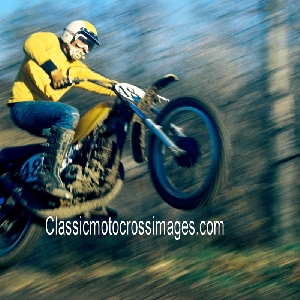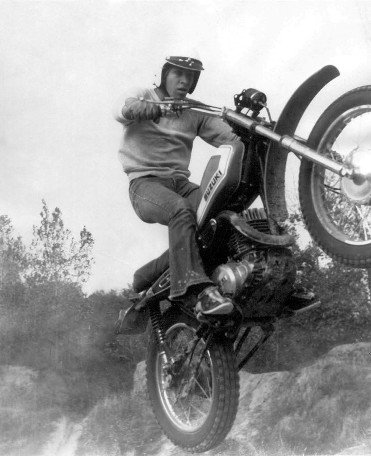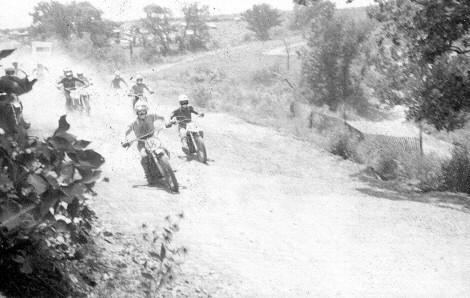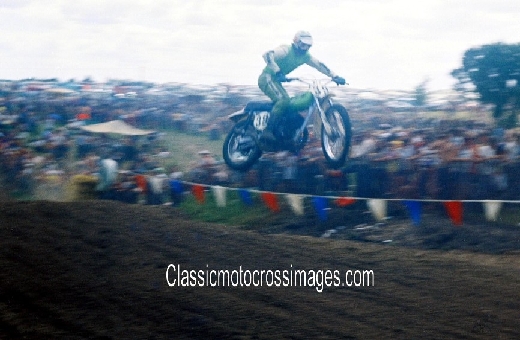
I have been an off road motorcycle enthusiast since the early 1970's. I raced motocross and hare scrambles and I was also a regional racing press photographer in-between the racing. I was lucky enough to cover nearby national and international motocross races of the day. I witnessed the start of American National Motocross racing first hand and saw incredible growth and changes. The grass roots beginning of the sport were worlds away from the extreme sports category it has grown into. It was a simpler time for sure but there were heroic things taking place as well. One of my main interests in opening classicmotocrossimages.com is to share old photos with similar enthusiasts. I hope to provide prints and even posters for those interested. For now I am building a web site to share a glimpse of bikes, riders and tracks that are a part of this rich history. The majority of these images have never been widely seen by the public. Even the ones published in the local "Checkered Flag News" were but a handful of the pictures taken during a typical race day.

Dirt Biking to Motocross
For me it all began in Kansas City when I saved up my allowance to pay for half of the whopping $350 cost for a Honda Minitrail 70 on my 14th birthday. I would ride that red Honda every day that I could and there was never anything up to that point in my life that I enjoyed more. The next year the movie "On Any Sunday" came out and it seemed like all my friends wanted to be like Steve McQueen and Malcolm Smith and ride dirt bikes. I moved up to bigger and faster bikes and my riding skills improved. In '71 a typical dirt bike of the day was nothing more than a Japanese Enduro bike with lights and turn signals removed. The real dirt bikes were European brands like Husqvarna and Bultaco but for the most part these were out of reach pricewise for the bluecollar boomer kids from the area. If you raced you typically stripped down a Japanese enduro and put engine kits on them to make them more powerful.
As luck would have it one of the largest dirt bike riding areas in Kansas City was within two miles of my house. Today this land is the World headquarters of Cerner Corporation but back then it was an area known as the "Avondale Flats" . This was nothing more than a small wilderness area developers had bulldozed out for fill dirt. Dirt bike riders were left alone in the place to carve out trails and eventually a small track appeared. On nice weekends riders from all over K.C. would show up and I was exposed to all kinds of riders and bike brands. Because it was free and centrally located offroad racers and shop based teams would sometimes come here to get some practice time in. My first two stroke was a Suzuki TS250 Savage. That thing was heavy and was quite a handful for a 15 year old but I wanted to be like Joel Robert and Roger DeCoster on their world beater factory works Suzuki's. I was becoming a pretty confident rider but when the racers appeared I found myself trying to keep up with them riding an inferior bike. They had the kitted bikes or European rides but I knew the place like the back of my hand and could hang with them most of the time.
By 1973 I was ready to start racing and bought my first motocross bike a Suzuki TM250. In looking back the production TM's were a far cry from the World Champion bikes but they did have a slightly similar appearance...........at least they were the same color yellow. I bought mine used from a local shop when one of their team racers quit. This bike came with a Bassani torque pipe and an evil CZ look alike tank that was ill fitting on the Suzuki. The photo at the top was taken of me during a practice ride on that bike.
My first motocross race was at Lake City Cycle Park near Blue Springs, MO. In those early races they had 3 motos per class. I actually got the hole shot and won my first moto and novice race overall. It was not without incident though. In the first race the fat Bassani silencer broke off about half way into the race and my bike was making a terribly loud noise and it caused the engine to lose power. I barely held on to win the first moto. The pipe was patched back together and in the other motos I did not get the holeshot and had to work my way up. I don't remember which moto it was but early in the laps I found out how evil that gas tank was. I had my weight forward on the tank going into a turn when a braking bump sent a crushing jolt into my crotch. I swear it was like a cartoon with stars and lighting bolts of pain flashing about and I almost pulled off the track. I forced myself to continue on and I managed to get the overall win. After this I always raced wearing my secret weapon, a cup.
Below I have the holeshot at Agency in 1973. In '77 I took a very similar picture at the start of a 125 National from the same perspective.

Early Days of Motocross
I quickly moved up in class and managed to trophy in every race my first season but the one thing that really stood out in my memory was a race I only spectated at. This was the 250 InterAMA race in Baldwin, KS my first pro race of any kind. It was an amazing scene and I was shocked to see how fast these guy's really were. I had not raced this particular track before but it was stunning. It was in a park like setting with many evergreen trees and hay bales and snow fences all around. The track was best described as loamy with rich Kansas farm land underneath and a thick layer of wood pulp on top from a nearby mill. The small shot at the top right was taken of Marty Tripes that day as well as the pictures below.
InterAMA Race
All of the top American riders were there such as Brad Lackey, Marty Tripes, Jim Weinert and Jim Pomeroy. Motocross started in Europe so at that time the faster riders were Europeans. Pierre Karsmakers, Heikki Mikkola and the two CZ factory racers from communist Czechoslovakia, Jaroslav Falta and Antonin Babravorski all were clearly the superior riders. Karsmakers was on a roll that season and won the overall but not before some drama. In the first moto Karsmakers felt the two CZ riders were blocking him. If I remember right Babravorski won the moto with Pierre on his tail the whole way. At the finish Karsmakers decked the first CZ rider he saw after the race which turned out to be Falta.
The pictures I took at Baldwin were just Instamatic photos from a 17 year old kid but they were historic because 1973 was the last year of conventional suspension on motocross bikes. Brad Lackey shows how it was done below. To think these riders could jump as fast and land as hard as they did, with less than half the wheel travel of a modern bike, was and is still hard believe. The technology revolution with motocross suspensions was coming, monoshocks and long travel suspensions were all just around the corner.
Click the buttons on the left hand side for the link to the press photos.
NEW January 2009: It has been two years since I opened this site and it has been great to hear from those of you who have visited and enjoyed the photos. I am adding a new section with miscellaneous photos I will change out every couple of months. Thanks for visiting and check back from time to time to see the updates under "Back in the Day"
.
Update Aug 2013 a special thank you to Cycle News for publishing their archives. This is the Holy Grail for historical racing details. Cycle News has graciously allowed me to provide additional race result details. It is very cool to read racing history as it happened. Check it out http://www.cyclenews.com/Archives
Randy Petree

I quick note about any of the pictures on this website. You may see some pixelization in some photos. The actual resolution of these images has been reduced for copyright purposes. If and when I make prints available they will be higher quality. For now this is my way of sharing these classic images.
|